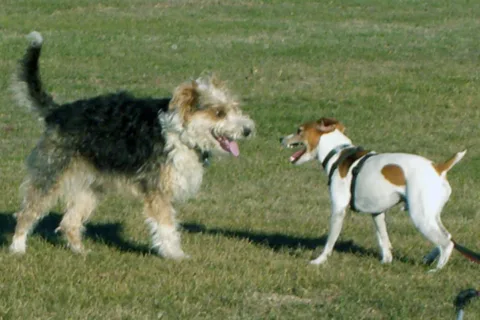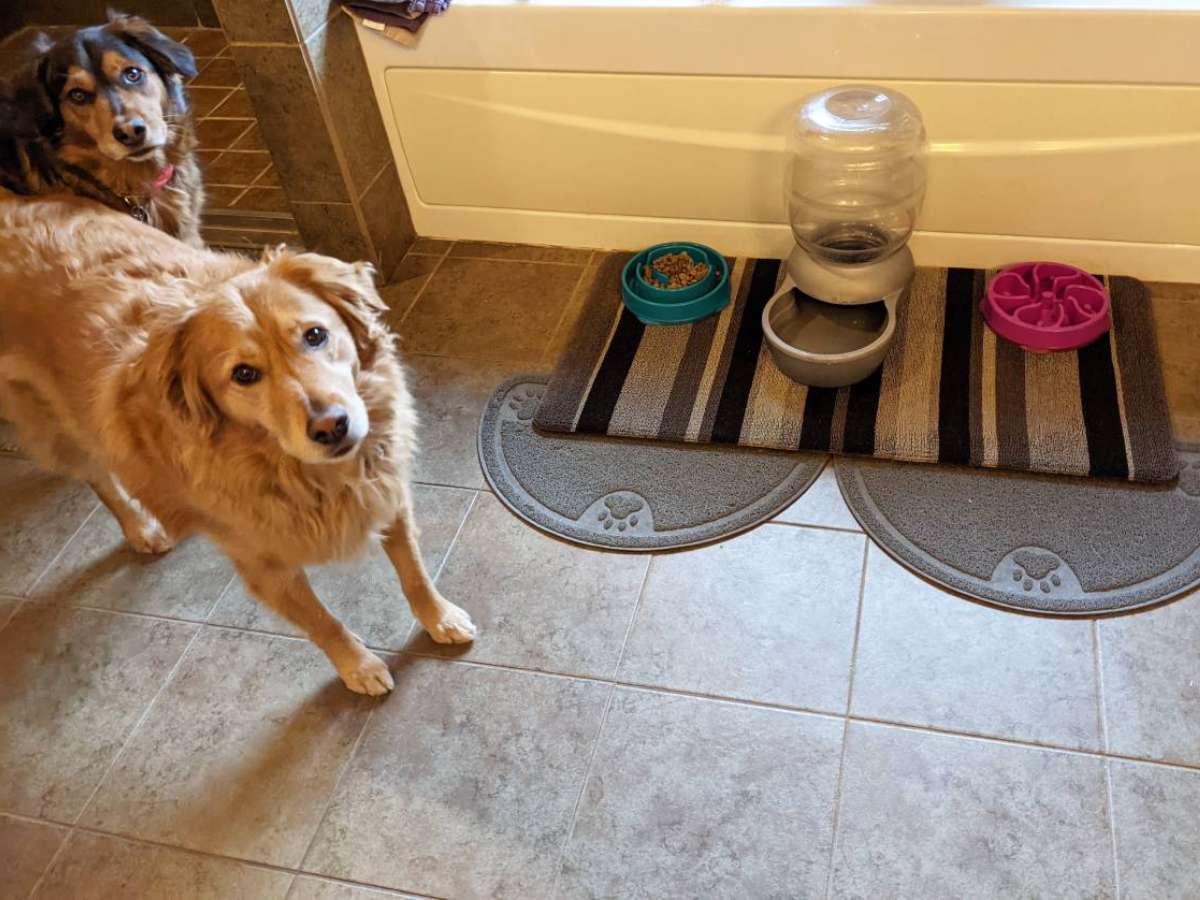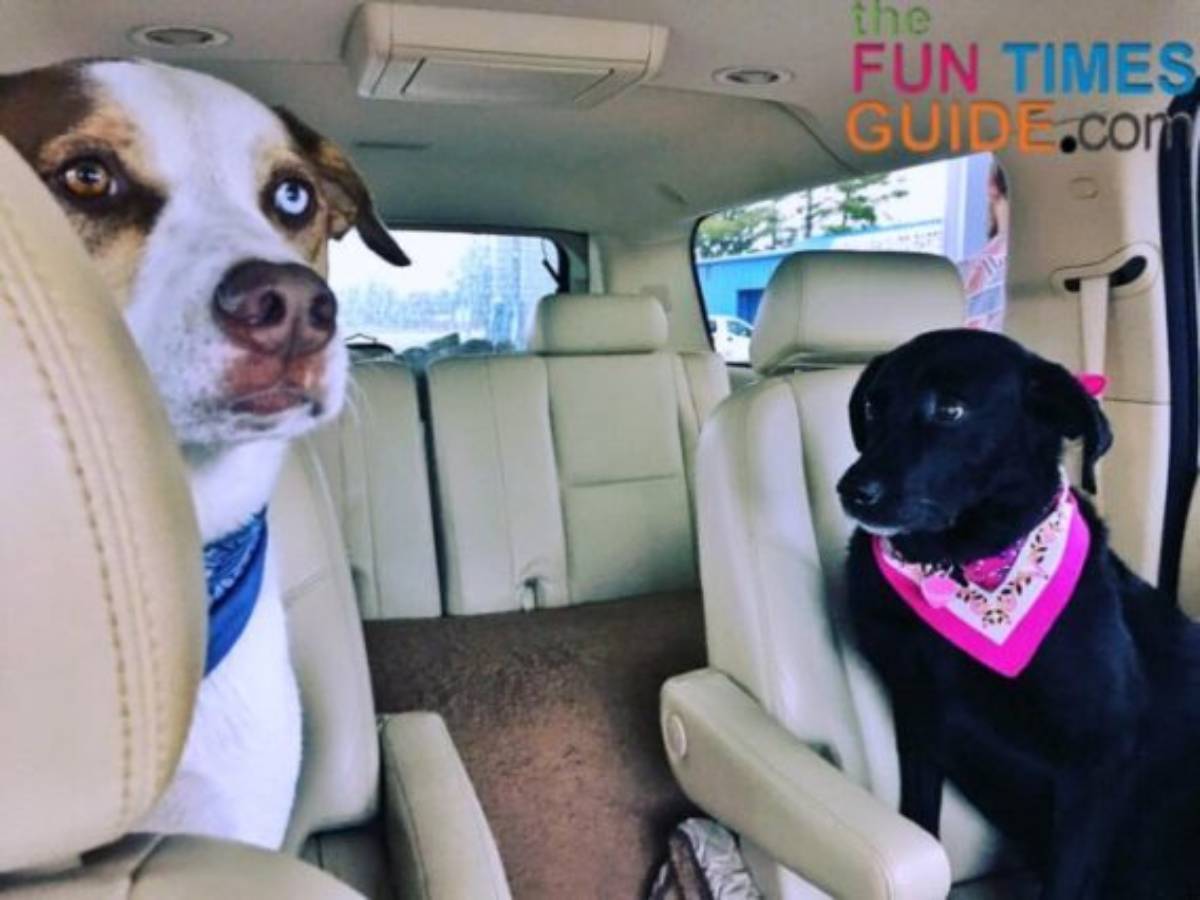Are you thinking of adding a second dog to your household? If you are, then be sure to introduce the two dogs to one another before you bring the new dog home.
The most important thing to do before you have two dogs in your house at the same time is to establish your role in the pack.
Yep, you read that right. To your dogs, you must always be seen as the pack leader for the group — from Day One.
You don’t need to take this to an extreme or anything. Just make sure that it’s always clear to your dog(s) that you are the chief around here. That’s all. This is actually helpful to a dog because pack behavior is in their genes.
The survival advantages of pack living remain in our domestic canines. Source
In this case, you will be their pack leader. The pack leader provides discipline, sets limitations, and defines boundaries.
You want to make sure that your current dog clearly knows who is boss in your household — so they don’t mistakenly think that they are the boss once the new dog enters the picture! This is especially true when the dogs are of the same sex.
Once you’ve done that, then you’re ready to introduce the two dogs to each other.
Here’s how to do it…
How To Introduce Two Dogs
Adding another dog to your household can bring you and your current dog more fun and companionship. However, it’s important to realize that your current dog, might feel similar to how you might feel if your parents picked your friends and then told you to share your toys with them. In the long run, things will probably work out fabulously, but in the beginning it’s a very smart idea to take a few extra steps to make everyone feel good about the new arrangement. Source
Do not just bring the two dogs together and hope for the best. You need to give a little bit of thought to how you are going to do things and how your dogs are likely to do things.
Try to stay calm, cool, and collected while the dogs get to know one another and don’t force them to get along. Some dogs take longer than others to get acquainted.
Try to let your dogs get to know one another slowly and on their own terms — one dog at a time — rather than having the new dog meet two or more other dogs at once, if at all possible.
Here are 4 steps to follow when introducing your current dog to a new dog:
- Neutral Location – Do this at a time when you have several days in a row to devote to your dogs’ introduction period — at least a weekend. First, have both dogs meet in a neutral location — such as a park or maybe the shelter where you are getting your new dog from. The idea is to choose a place that your current dog is not territorial over. That’s why it’s never a good idea for two dogs to meet for the first time in your home. Ideally, the dogs will be on very long leashes, so you will be able to enact some control if need be, yet the dogs will have the freedom to explore one another without feeling the tension of a leash (which could be an irritant to an already stressed dog).
- Positive Reinforcement – Have someone help you by having one dog on a leash, while you have the other dog on another leash. Allow the two dogs to sniff one another… like this. This is the canine version of ‘breaking the ice.’ It’s natural and non-confrontational. Praise both dogs with calm, positive words. Do not use a threatening tone, because this could cause fear or nervousness in one or both of the dogs. It could even cause the two dogs to become aggressive. Once everything is going good, have them sit, and then reward them both with a treat.
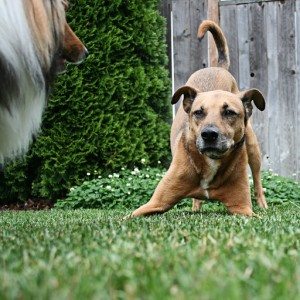 Body Postures – Watch both dogs’ body posture. If one dog is doing a play bow, this is a good sign. This tells the other dog they would like to play. A quick jerky hop to one side is another playful sign. Keep an eye out for aggressive responses too — like the dog’s hair standing up on his back, showing teeth, a deep growl, or a prolonged stare. At the first sign of aggressive behavior, interrupt immediately by calmly getting both dogs’ attention. Once distracted, use the 3 second rule, then try introducing the two dogs again, but take it slowly. Only allow the two dogs to sniff each other for a few seconds at a time until it’s clear that both are comfortable. Once neither seems to care much about sniffing the other any longer, it’s time to take them home (in separate vehicles) and introduce them on home territory.
Body Postures – Watch both dogs’ body posture. If one dog is doing a play bow, this is a good sign. This tells the other dog they would like to play. A quick jerky hop to one side is another playful sign. Keep an eye out for aggressive responses too — like the dog’s hair standing up on his back, showing teeth, a deep growl, or a prolonged stare. At the first sign of aggressive behavior, interrupt immediately by calmly getting both dogs’ attention. Once distracted, use the 3 second rule, then try introducing the two dogs again, but take it slowly. Only allow the two dogs to sniff each other for a few seconds at a time until it’s clear that both are comfortable. Once neither seems to care much about sniffing the other any longer, it’s time to take them home (in separate vehicles) and introduce them on home territory.- Take Dogs Home – After you’ve introduced the two dogs properly on neutral ground, then it’s time for them to interact for the first time together inside your home. With both dogs on leashes, let the new dog enter the house first, followed by your current dog. At least for the first few days they’re in your home together, put both dogs in crates (or separate rooms). I you don’t want to fully crate train them, then at least get them used to going in their crates for any extended periods of time that you are unable to watch them closely. When you notice that your current dog has less of an interest in the new dog and stops keeping an eye on him so much, that’s when it’s okay to let the two dogs interact freely within your home. Remember to support the dominant dog by feeding him first, giving him toys first, giving him attention first, etc.
Here are some tips to ensure that your dogs continue to get along inside your home.
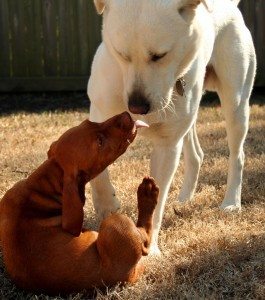 Sometimes, older dogs are aggressive with new puppies. If that’s the case, just make sure that your older dog does not hurt your little puppy — especially during those first few days.
Sometimes, older dogs are aggressive with new puppies. If that’s the case, just make sure that your older dog does not hurt your little puppy — especially during those first few days.
Puppies usually pester adult dogs unmercifully. Before the age of 4 months, puppies may not recognize subtle body postures from adult dogs signaling that they’ve had enough. Well-socialized adult dogs with good temperaments may set limits with puppies with a warning growl or snarl. These behaviors are normal and should be allowed. Source
If introducing the two dogs does not go smoothly for you, then find a local dog trainer to help you — and your dogs — get on the same page. (Remember, they do this for a living. You’re definitely not the only one who needs this type of help!)
You could also ask your vet for some good — inexpensive — trainers in the area.
Never pat a dog showing signs of aggression. If a dog is showing signs of aggression; growling, barking, etc don’t be quick to pet to calm them. Doing so only encourages this aggressive behavior. Only pet or show praise towards your dog when they are calm, obedient and on best doggy behavior. Source
What Are The Dogs’ Personalities?
You can use these same tips when introducing your dog to other dogs at the dog park as well.
Many don’t think about the dogs’ individual personalities beforehand and just let all of the dogs run straight for one another to meet and establish their own dog hierarchy.
Like most animals who live in groups, dogs establish their own social structure, sometimes called a dominance hierarchy. This dominance hierarchy serves to maintain order, reduce conflict and promote cooperation among pack members. Source
Since I’ve seen firsthand the outcomes that can occur when putting dogs together for the first time, I prefer to keep my dog on a long, loose leash until I can tell that he’s comfortable in the group. (It doesn’t take long.) Then I stop being the over-protective mama and let him enjoy being a dog.
Here’s a good way to think about a dog’s personality and mannerisms:
If you were to compare your dogs to a traffic light, would you say they are “green light”, “yellow light”, or “red light” dogs? A green light dog is friendly with all dogs and people and has appropriate meeting behaviors. Yellow light dogs are those that are friendly but you should use some caution in managing their interactions. Whereas, red light dogs are very reactive toward other dogs and/or people. This reactivity is usually aggressive looking. However, with some dogs, it is friendly but extreme excitement that would cause most dogs to attack them due to their out of control, over the top, excited approach. You probably know which traffic light color your current dogs are as you have observed their interactions with others in many different situations. If a current dog or the new dog would be considered a “red light” dog, you should not introduce them without the professional assistance of a Certified Dog Behavior Consultant. Most aggressive red light dogs will lead happier lives being the only dog in the household and it is not worth the risk of injury to try to introduce them with other dogs in the household. Instead, the goal should be to work with a consultant one to one, so that the red light dog can become a yellow light dog enabling you to walk your dog in public places. Source
This video give 2 different examples of dog-meet-dog encounters. One went well. The other… not so much!
More Tips For Introducing Two Dogs
- Introducing A Dog To A New Home With Other Dogs
- How To Ensure Your Two Dogs Get Along
- When Conflict Arises With Two Or More Dogs At Home
- Tips For Managing Multiple Dogs In Your Home
- What To Expect The First Couples Weeks At Home
- How To Break Up A Dog Fight
- Dog Introductions: What To Do And What NOT To Do
- Introducing Your Dog To Other Animals In Your Home
- What Do Do About Dog Fights
- How To Manage Your Multiple Dog Home

